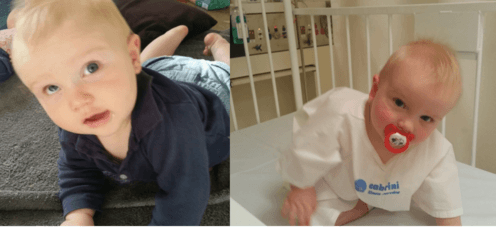
It is amazing how much can happen in a couple of months.
About 10 weeks ago my husband and I started to get the feeling that Joe was favouring his right eye. The more we looked the more we realised that he always had that eye higher than his left. He held toys in his right hand and would roll or sit in a way that allowed his head to stay tilted.
I mentioned something to a colleague at work who happened to be having lunch with a paediatric optometrist. A few days later little Joe was being tested. Unfortunately Joe was so determined to keep his head tilted on the side that it was impossible to test his eye properly. I was told that if I ever see his right eye roll upwards when he looks towards the left, then I should take him to see a specialist.
Over the next couple of days I tried every trick to get him to look in that direction, but it was obviously so unpleasant for him that he simply refused to look (or would roll on to his back so he could see the toy without having to move his eyes in that direction). Finally I found a toy sufficiently interesting to get his attention and I managed to take a quick photo while his head was tilted the opposite way.
Four weeks later he was having surgery.
Eyes
When I began writing this Babies vs Science column over three years ago, the brief was to cover issues that intersected my life as a mother and research scientist. I never expected these two aspects of my life to collide to the extent that they have with little baby Joe.
Since well before Joe’s birth I have been a little obsessed with my kid’s eyes. This is partly because my husband and his three siblings all have significant problems with their vision. But also because one of my primary areas of research is visual perception and my PhD supervisor, Professor Jack Pettigrew, did some of the earliest work looking at binocular vision.
Much of my own research has focused on the perceptual suppression that occurs when the images of the two eyes are misaligned. It turns out that if the brain can’t fuse the two images into a coherent percept, it simply suppresses one eye’s image.
You can do this in Binocular Rivalry experiments using mirrors or other tricks to present two different images to the two eyes. Such as using a piece of rolled up paper – as shown below.

It is a fantastic tool for consciousness research, because when people view binocular rivalry stimuli they will consciously experience one eye’s image while the other image is suppressed from awareness.
After a few seconds awareness will switch so that the previously suppressed image begins to dominate. If you are interested in how the brain generates a conscious experience these regular switches between consciousness and suppression offer an ideal insight into this process.
Outside of the lab, this sort of suppression also happens if one eye is pointing in the wrong direction, or is impaired in some way and only able to provide the brain with an image that differs from the good eye. Under these conditions the brain simply suppresses the bad eye’s image –- permanently!
This is referred to as amblyopia, or “lazy eye”, and is often treated with patching, with the idea being that patching the good eye will force the bad eye to work harder and prevent its permanent suppression.
In Joe’s case his eye misalignment was considered very severe and a little more unusual because it would roll up rather than off to one side. So it was decided that surgery was needed and the sooner the better.
Hospital
In many respects we are extremely lucky; having to attend occasional graduate student supervision meetings at the Children’s hospital, I know how unfair life can be for some families. But it is still quite a lot to take in.
Even when you know the problem is comparatively minor, it is hard when it is your own child that needs to be fasted for hours and then held down while they struggle against the anaesthetist trying to put him to sleep.
In our case one thing that made things easier was the knowledge that surgery was 100% required. I have not been in this position before, but I was surprised how hard it is to overcome the instinct to prevent/reduce any pain and suffering experienced by your kids, even when you know with complete certainty that temporary pain will make things much better in the long run.
As an aside, I did wonder if this instinct underlies some parents’ reluctance to immunise their children despite the overwhelming evidence of the, sometimes life saving, benefit.
In our case it was clear Joe would likely lose function of his right eye without surgery, so even a risk of infection or potential damage to the eye was comparatively inconsequential.
It appears that the operation was a success. Although I have to admit I was not filled with optimism when the surgeon finally emerged from theatre and declared “I’ve never seen anything quite like that before!”
It turns out that not only was Joe’s eye muscle extremely week, it was also attached to the eye in the wrong place and only secured to the superficial layer of the eye, called Tenon’s capsule.
It is likely he will need more surgery down the track, and he has to wear a patch for an hour a day, but all things considered he is lucky that it was picked up quickly and he should retain most of the function in his eye.
And his siblings, Susie and Max, are ecstatic: their little baby brother has turned into a pirate!
Disclosure
Olivia Carter receives funding from the Australian Research Council.
